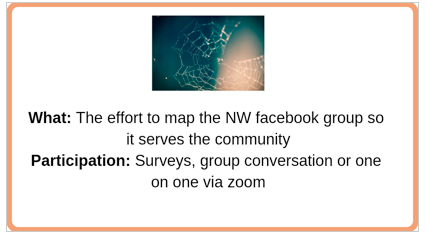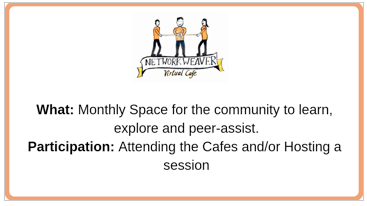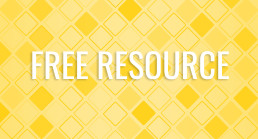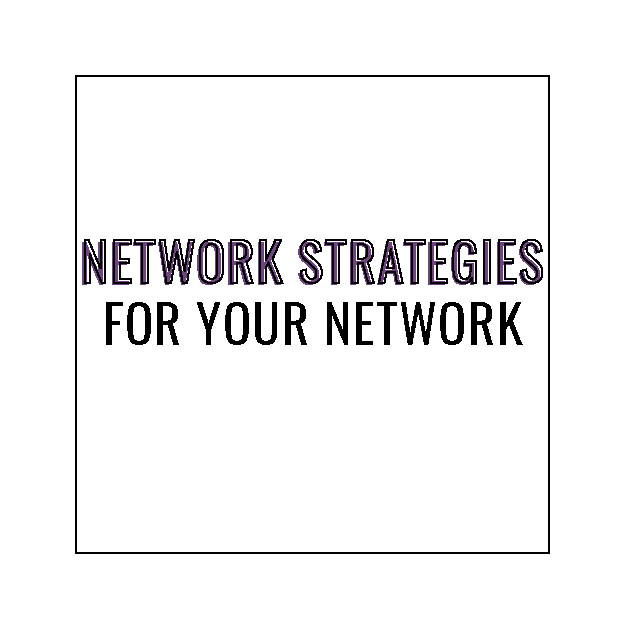Weaving the Weavers : Efforts to co-create global learning and peer assist
[ap_spacing spacing_height="20px"]Let´s be honest Network Weaving is super fascinating. There are so many activities that we, network weavers, can contribute to to make communities vibrant and effective. Surely, you have your own story and connection to what got you into network weaving. We can seize modern technologies to connect and and share these stories and our learnings.
There is a Facebook group called Network Weaving that currently has about 1800 members. There already has been a vivid exchange of resources and learning through posts and comments. At the beginning of this year some members began further deepening the potential of this amazing community. There are efforts to build a network map and the establishment of regular online formats. In this blog post I will give a short overview of what has been happening so far and how you may participate in the journey.
[ap_spacing spacing_height="20px"]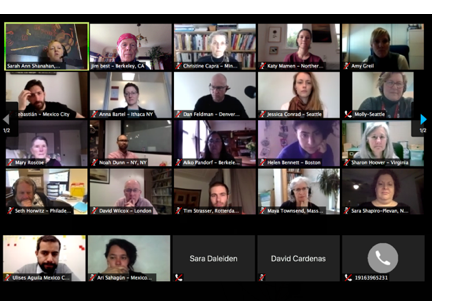
[ap_spacing spacing_height="20px"]
Purpose and Needs
Both the mapping efforts and the virtual cafe identified the needs in the community. Both groups found similar themes and purposes, which cover:
- To help the community discover its identities, building trust-based relationships, and encouraging/facilitating collaborations and learning.
- To further build the field of network weaving, understand its potential and role in systemic change.
- To deepen information flows, to connect related capacities and to attract more abundance to our work.
[ap_spacing spacing_height="10px"]
What has been happening
The network mapping journey
The journey to create a useful network map is highly participative and members of the network weavers facebook group are encouraged to join in any step of the process that is the right fit for them. There are three distinct phases that we are working through; First, we are taking the time to envision and get a better sense of what the community wants, needs and values. Once we have that clarity we’ll move into a technical phase where we’ll build the map. Finally, we’ll work together to make sense of what we are seeing in that map. We kicked off the envisioning phase with twenty seven members of the Facebook group in a zoom session with the larger group having been invited to contribute their perspective in a survey.[ap_spacing spacing_height="10px"]
The Master Mappers have extensive experience with network mapping. Christine Capra, Sarah Ann Shanahan, Maya Townsend, Lisa Negstad, Jim Best and Drew Mackie serve with their efforts and knowledge to facilitate learning, increase the awareness regarding passions and relationships within our community, and to develop the mapping skills of network weavers. This is the process of the mapping and as you see you can work closer with the Master Mappers, fill in surveys and attend the convenings.
[ap_spacing spacing_height="10px"]
Next Meeting on the 2nd April 9:00 -10:30 a.m. CT
Register at:
https://zoom.us/meeting/register/3e12488a815da90c8c34be5db4a05ad8
[ap_spacing spacing_height="20px"]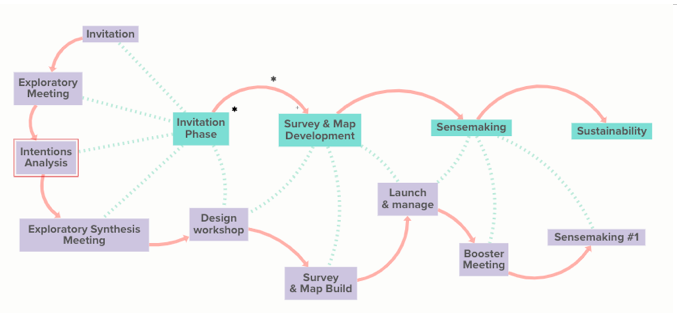
[ap_spacing spacing_height="20px"]
The Virtual Cafes, hosted by an open group of facilitators each month, aim to intensify learning, peer assistance and our service to systemic changes. There have been two cafes so far and the next one is coming up at the 4th of April. The hosts are currently Tim Strasser, Nenad Maljković, Ben Roberts, Jim Best, Keala Young and Adrian Röbke. The hosting group is open. Whomever wants to contribute is very welcome! In the last cafe on the 7th of March we explored our learning wishes and already dove into some of them in an open space, which is one of the many interactive formats we will use to have fun. These wishes to which you can add anytime are a basis for further explorations and journeys.
[ap_spacing spacing_height="20px"]
Event Link: https://www.facebook.com/events/248389826079525/?event_time_id=248389829412858
So this is about it. Personally, I feel lots of excitement and curiosity about what we can co-create as a global community. After just three gatherings I have made lots of good connections and I am sure that really cool ideas will emerge when we get together! Looking forward to seeing and hearing you soon!
[ap_spacing spacing_height="10px"]
Adrian Röbke
[ap_spacing spacing_height="20px"]
Photo by Kyle Glenn on Unsplash
Network Weaving
Network weaving plays a critical role in community development strategies of all kinds. In the Connected Community Approach, networks of residents, organizations and institutions are central to creating place-based systems change.
In this video local community builders share their stories, skills and insights as they explore the tremendous impact network weaving can have on the health and vitality of community.
For more examples of the Connected Community Approach in action, please visit www.thestorefront.org
For more tools and ideas on how to create your own connected community, please visit www.connectedcommunities.ca

Network Weaver Virtual Cafe - Kick-off
[ap_spacing spacing_height="20px"]
Adrian Röbke and Nenad Maljković are hosting a Network Weaver Virtual Cafe kick-off.
WHERE: Zoom link: https://zoom.us/j/158170326
WHEN: February 8th, 2019. 16:00 - 17:00 UTC (in your time zone)
DETAILS:
To further build our global community, we'll begin by getting to know each other and share stories on what brought us to and fascinates us about network weaving.
We will then explore what regular virtual talks can do for us to fulfill our needs and answer some burning questions.
Lastly, there will be a short bit on practical manners: In which rhythm do we want to do the sessions? Who facilitates? How do we fit all of our themes and needs into an exciting format?
[ap_spacing spacing_height="30px"]
The Power of Networks
If you’re like most nonprofit leaders, you’re devoting significant effort to your networks. But what return are you seeing on that investment?
I recently spoke with 500+ nonprofit leaders at Nonprofit Driven 2018 and emphasized 3 simple truths about strong, impactful networks.
[ap_spacing spacing_height="30px"]
1. Network leadership is different from organizational leadership.
[ap_spacing spacing_height="10px"]
Organizations tend to have strong, stable structures and centralized decision-making. Leaders prioritize goal achievement, alignment and retention.
Networks are loose, unstructured webs of relationships. People are engaged in autonomous yet connected activities to achieve a shared purpose. Activities are emergent and often undefined; people come together when there is energy and opportunity. Network leaders have to be humble co-leaders that lift their gaze above individual organizations to see a greater purpose.
[ap_spacing spacing_height="30px"]
2. Networks are grounded in trusting relationships.
[ap_spacing spacing_height="10px"]
The success or failure of networks can usually be traced to the condition of their relationships. Like any relationship, trust is key. Easy to say, but how do you do it?
[ap_spacing spacing_height="15px"]
I. Visualizing your network can offer powerful insights.
Network mapping can be a powerful trust building process, especially when you engage network members in making sense of it together. Seeing the system of relationships can illuminate barriers and opportunities to build equity and trust.

In some networks, one person (the hub) knows many individuals who aren’t connected to each other (spokes). This can limit and potentially block the flow of information and resources.

II. Closing triangles.
Hubs need to “close the triangles” – build relationships between disconnected people. Closing triangles is a key strategy for weaving ecosystems of trust in which:
• People are meaningfully engaged
• There aren’t gatekeepers
• Diverse perspectives can be fully integrated, and
• Leadership is shared.

III. Set the table for inclusion.
How you set up a room, design an agenda and facilitate a dialogue can either limit or build engagement and inclusion. I recommend Liberating Structures, a set of creative yet systematic facilitation tools that leverage everyone’s contributions.
[ap_spacing spacing_height="30px"]
3. Networks enable community building and social impact.
[ap_spacing spacing_height="10px"]
To make a social impact, networks also need to take collective action. Here are four essential practices:
[ap_spacing spacing_height="15px"]
I. Foster shared purpose.
Shared purpose sustains momentum. Prioritize the purpose and align your strategy to realize it.
[ap_spacing spacing_height="15px"]
II. Foster co-creation.
Mechanisms like Liberating Structures and purpose-driven working groups enable co-creation and build shared ownership.
[ap_spacing spacing_height="15px"]
III. Foster collaborative leadership.
Shared power is key in networks. Regularly analyze how the network is functioning, close the triangles and guide the work together.
[ap_spacing spacing_height="15px"]
IV. Foster generative learning.
Make space to reflect and gather the collective wisdom. Nurture a culture of curiosity and develop agility through learning.
Have you unleashed the power of your networks? Integrating these 3 simple truths and a few proven practices can help make your networks effective and impactful.
[ap_spacing spacing_height="10px"]
Lisa Watson is the Co-Founder & CEO of Openly, a strategy, research and design firm enabling changemakers to achieve social impact. She is also a faculty member at the Banff Centre for Arts & Creativity.
Originally Published on November 8, 2018 at Hilborn: Charity eNews
[ap_spacing spacing_height="15px"]We encourage you to comment on this post so we can hear about your thoughts and experience.
A Network Connector Story
Sometimes a story can convey meaning better than a lecture. This week's free resource is a story from the early days of the Appalachian Center for Economic Network's (ACEnet) Kitchen Incubator describing how staff were network weaving small food producers in our region.
This focus on connecting people is important no matter what type of organization or network you are part of! We'd love to hear your network weaving stories.
Network Strategies For Your Network
This video is about 20 minutes long and provides a short overview of network strategies. It was done for the Food Policy Network State Networks, who graciously agreed to let me share it.
The video emphasizes the importance of being part of networks of networks and of catalyzing self-organizing to move us to a more experimental, learning and viral space.
Networks of networks and self-organizing are the key factors needed to shift systems.
[ap_spacing spacing_height="10px"]
Communities of Practice for Network Weavers
The most effective way for people to build their skills as Network Weavers is to set up a Community of Practice –a group of people who share an interest in developing skills in a particular area. [ap_spacing spacing_height="10px"]
A Community of Practice encourages people to identify their learning needs and organize training, coaching, and peer support to meet those needs.
Participation in a Community of Practice is voluntary: we find that usually those eager and natural Network Weavers form a core group, but as they employ network weaving in their work, others see the benefits and become interested in building their skills as well and become more active.
A successful Network Weaver Community of Practice begins initially with some external training, since there are few highly skilled Network Weavers at this point. It’s usually effective to have a small core group of natural Network Weavers work with the trainer so that they quickly are able to conduct much of the training themselves.
Those individuals might have extra sessions to read and discuss resources that could deepen their understanding of networks and self-organizing so they are working from a strong theoretical base. The external trainer(s) could then focus on coaching this core group.[ap_spacing spacing_height="20px"]
Peer Assist
A core practice of a Community of Practice is the peer assist. This is where one individual, project group, or network has a challenge and seeks the thinking and advice of others in the Community of Practice. [ap_spacing spacing_height="10px"]
THE PROCESS IS:[ap_spacing spacing_height="5px"]
- The individual or group presents their situation and the challenge it is facing.[ap_spacing spacing_height="10px"]
- Those listening then ask clarifying questions which are answered.[ap_spacing spacing_height="10px"]
- Those listening then provide ideas, questions, and suggestions; they suggest sources of information or other cases that may help the challenge group.[ap_spacing spacing_height="10px"]
- The challenge group then responds.[ap_spacing spacing_height="10px"]
- The listeners talk about how this gave them ideas for their own network or project.[ap_spacing spacing_height="10px"]
- The entire group reflects on the session and insights gained.[ap_spacing spacing_height="10px"]
- The group determines whether there are any next steps or whether they want to continue the discussion in any way.
A peer assist can be 30-60 minutes long.
Here are some comments about the benefits of peer assists from participants in a recent Community of Practice:
“It was great to show my network how to build trust among our volunteers who are spread out statewide and may not have ever even met each other.”
“From my peer assist I took away the concept of planning in chunks --giving network participants a broad learning trajectory but doing detailed planning in small chunks in order to leave space for addressing emergent interests / needs.”
“I gained good ideas from my colleagues of ways to approach networks and a variety of traditional and social media tools to incorporate to enrich the experience for the entire network.”
“It gave me a better view/perspective on how other networks apply network weaving within their own agencies. I was also able to get additional resources and information how to better address the issues that arise from our network. I also love the personal stories and the friendships forged from the exercise.” [ap_spacing spacing_height="20px"]
Learning Popup
Another activity, called a learning popup, supports on learning about a specific topic. An individual identifies something that he or she wants to learn and invites others to join in a learning popup. They may need to bring in an expert, or one of the participants may have advanced knowledge in the area. The group meets, determines a learning agenda and sets up one or more sessions to complete this agenda.
It’s very easy to hold Communities of Practice on zoom.us, an easy-to-use video conferencing platform.
For further learning, see Abby Yanow's post on Best Practices for Communities of Practice.
[ap_spacing spacing_height="20px"]
We encourage you to comment on this post so we can hear about your thoughts and experience.
[ap_spacing spacing_height="20px"]
[ap_spacing spacing_height="20px"]
Trust: Foundation of Effective Networks
This article is a chapter from the Network Weaver Handbook with several worksheets you can use with your networks, projects and organizations.
They go together nicely with the blog posts Trust in Networks is Fundamental to Social Change by Christine Capra and Trust in Networks by June Holley.
[ap_spacing spacing_height="20px"]
What’s With The Network Weaving Thing?
[ap_spacing spacing_height="20px"]
I became a rabble-rousing, injustice-fighting, demonstrating, boycotting, marching, chanting, banner-carrying, strategizing, counter-culture activist early
– by age 13 I’d faced my first line-up of National Guardsmen un-accompanied by any adults who knew me.
By my mid-20’s, though, I was utterly disenchanted. The issues were still real & unacceptable, but activism had proven ineffective. Nothing ever really changed.
The direct-attack approach just burned through energy and resources, without getting anywhere near the roots of the problems. We were all too far outside the systems that needed to change – those systems were too well-protected.
Activists were hysterical misfits attaching themselves aimlessly to random causes, more for the adrenaline & thrill of disruption than out of commitment to anything in particular. I tired of the endless power-struggles, and people projecting their own unacknowledged emotional problems onto larger social issues (which, you know, maybe I was still doing a little of that myself. . .).
Plus, by then I was a single mom & needed to support my kid. I settled down, quit tilting at windmills and became pragmatic. Well, I tried to anyway.
Ultimately, I discovered that activists were no more dysfunctional than other groups – they just had fewer carrots & sticks to keep things focused was all.
My need to make things better shrank down to the confines of my employer organizations & specific work-related initiatives, but even so, change was hard work. And regardless of context, carrots & sticks seemed crappy substitutes for passion, intrinsic motivation and vision.
[ap_spacing spacing_height="20px"]
Some questions can’t be avoided
So the question still was – how can groups of people work together more effectively to solve problems – without coercion? And without the financial reward that imposes it’s own priorities, and inherently skews solutions toward the market, whether market solutions are appropriate or not? Or maybe more to the point – how do you access the passion & motivation & vision inherent in all would-be change-agents in a way that helps them fulfill their own personal missions while still moving toward larger collective goals?
I contemplated those questions so long that I decided to get a Master’s Degree in Organizational Leadership – and discovered Wheatley, Senge, Bohm, Scharmer, Kahane, Meadows, Semler, Argyris and so on & so on & so on.
I found a whole new world of systems thinking, collective wisdom, dialog, self-organizing systems, complexity – it all was exactly what I’d been missing all those years. I was in intellectual heaven, completely engrossed. I felt like I’d found the key to the Universe.
At first I tried to apply what I was learning in my work-place – not so successfully. Eventually I realized that profit-oriented hierarchies aren’t the best fit for the approaches I was interested in. I wasn’t positioned to change the secretive, hoarding, clinging, fearful, linear, bottom-line, controlling minds at the top – and eventually realized it was stupid to even want to – just more tilting at windmills.
I moved on to experimenting in the real world – in loose groups gathering around causes & ideas, collectives trying out new ways of working together, etc.. This was a better fit, a more conducive context. But still, collectivity & change were hard.
There were all these lovely new methodologies – Appreciative Inquiry, World Café, Open Space Technology, Dialog, Theory U, Human Systems Dynamics, Scenario Planning, Theory of Constraints, Design Thinking, etc., etc. – most of which, though wonderful, seemed best suited to more bounded & narrowly defined situations. Or are applicable to smaller groups, or larger groups. Or less diverse groups, or ones with smaller gaps in privilege & equity, Or they require a ton of time, money, expertise and planning. Or they’re so conceptual & abstract that people mired in real-world, right-now issues just can’t focus on them long enough to give them a chance. Or else . . .
[ap_spacing spacing_height="20px"]
I’d found a key, but for which door?
I wasn’t looking for the keys to corporate change – I was stalking change & emergence in self-selecting groups attempting to make huge differences. I was back to my activist roots, wanting to solve the big, big problems, like poverty & ecological sustainability, white supremacy & urban livability & climate change. Big overlapping, complex problems that require collaboration & passion across all kinds of differences. Problems that demand more than one vision, myriad visionaries, multiple strategies & that won’t oblige central command & control.
And the thing is – the answers are still emerging. There’s a ton of good work going on, but everyone is still learning. There’s no one size fits all. We’re not ‘there’ yet (if ‘there’ even exists anymore, or ever did).
Anyway – all of that above is my long-winded way of telling you my bona-fides, my credentials – why I feel qualified to say what I’m going to say next. Which is:
Network Weaving is darn close.
So, if Self-organizing is the key, then Network Weaving is the lock and the door & the turning bolt & the handle & the hand & the doorframe & the. . . you get the point. I don’t mean it’s the only key, or the be-all or end-all. But it’s scalable, flexible & fits a lot of contexts.
I wouldn’t have suspected that.
[ap_spacing spacing_height="20px"]
I didn’t start out all that psyched about Network Weaving.
It just seemed like another relevant but small piece of the puzzle – of course you need networks, but there’s a lot more to it than that. . . (I think I was still enamored of complexity – I wanted it to be more sublime).
But no – I got to Network Weaving through my background in data analysis, gathering & visualization – I mapped some networks. For money. It was just another opportunity to fiddle on my computer, mess with spreadsheets & make something pretty (a tech-y version of pretty that is) – which is one part of what I’ve done for a living for awhile now.
But it did amplify, in my own mind, the one thing that became crystal clear in all my earlier experiments – just inviting a lot of folks & getting them to the table isn’t enough. Even with all those beautiful methodologies.
If the quality of the connections isn’t high enough to get meaning & value flowing – you just have a lot of happy-talk. And disenchantment. And no change. In spite of shared vision & simple rules & all those other important components.
It all still comes down to the foundation – the interdependence that bonds us together.
If the human bonds at the core of the system aren’t strong & trusting, not much new will happen. And Network Weaving is all about creating, not just connections – but connections that can carry weight. It’s about meaningful connections, resource-sharing connections, mutual-aid & mutual-growth & mutual-survival connections.
So Network Weaving as the way into Self-Organizing just kind of grew on me.
And network mapping as the way into Network Weaving started to seem inevitable – work I had to do.
And I don’t mean just Social Network Analysis (SNA). No, SNA was just another game for data-dweebs. Used in organizational decision-making & marketing & fundraising & influence peddling – also good for researching disease transmission and terrorist cells and other scientific purposes.
No – I quickly became interested in a specific application of Social Network Analysis, and only as a small piece of what I imagined was possible through interactive network mapping.
What became meaningful & exciting to me was the potential for self-organizing & transparency & real resource exchange (just like in a living system) that an interactive, online network map could facilitate. Interactivity promised to enhance the conditions necessary for self-organizing. And while I was trying to figure out cheap ways of making the tools I had at hand more interactive, Kumu.io made a huge leap in that very direction & provided the perfect platform for what I was dreaming up. Which clinched the deal, that was my entry point. A method I could finally get behind & settle into. It was time to absorb everything I could about the Network Weaving methodology.
And, as I did, I started to see that Network Weaving contains the skills, the process & the methods to help self-organizing come into being (without bogging down in theory).
Network Mapping is just one part of the whole picture – the part my husband Tim & I are especially qualified to help with. But I have learned enough about self-organizing & systems & complexity & human trust and passion and intransigence, to recognize that Network Weaving, combined with a good interactive network map designed around your particular network’s specific needs, has the potential to break through all that ineffectiveness that frustrated me about back-in-the-day activism.
It’s not the only or the final answer, but I don’t think you can go wrong to include network weaving & a network map in your collective change efforts. And the purpose of this blog is to help with that.
What’s your experience with Network Weaving? And how could I help enable your network weaving & mapping practice? Please comment below.
[ap_spacing spacing_height="20px"]
originally published at Greater Than The Sum on June 24, 2015
Network Toolkit for Network Weavers
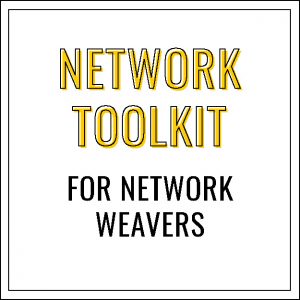 Want to know how start with network building?
Want to know how start with network building?
This free toolkit offers a set of activities you can incorporate into your next gathering to set you on a path to an effective network.
It includes speed networking, PostIt note mapping, closing triangles and other processes that anyone can easily facilitate.


